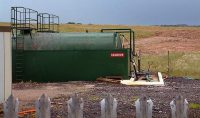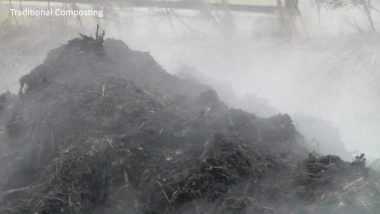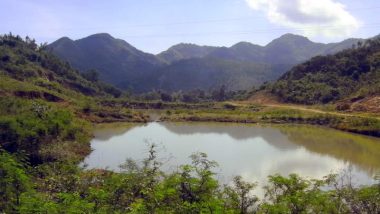For this case study on Methane Stripping from Landfill Leachate, IPPTS Associates’ role was to act as the leachate expert for a centralized methane stripping facility to serve 4 landfills in the counties of Yorkshire and Derbyshire.

Duties were to design a methane stripping plant (MSP) in outline, write up the technical specs, and procure four methane-stripping water treatment plants for the international solid waste management company client, FCC (formerly WRG). These plants remove methane from the leachate from four FCC landfills in Yorkshire and Derbyshire.
The purpose of the leachate methane stripping plant (MSP) work was the removal of dissolved methane from landfill leachate to enable the resulting de-gassed leachate to be discharged to the public sewer.
The work included providing the outline MEICA design and tender documents. This work has now been completed; the plants have been commissioned and are working successfully.
Those were the main tasks. If you wish to know more, read on!
Methane Stripping: A Case Study on Dissolved Methane Removal from Landfill Leachate
This case study explores the process of dissolved methane stripping from landfill leachate. Learn about the aeration tanks used for methane removal and storage at these four sites.
In this article, we will delve into the process of removing methane gas from landfill leachate and the importance of this practice for compliance with the applicable health and safety regulations in the EU ATEX Directives.
The Process of Methane Stripping
Landfill leachate is a complex liquid that is generated when water comes into contact with waste materials in a landfill. Methane stripping is a treatment method used to remove methane gas, a potent greenhouse gas, and a highly explosive one, from this leachate.
Methane is routinely present in leachate as it exits landfills as dissolved methane due to the ubiquitous presence of biogas inside all modern sanitary landfills.
The process of dissolved methane stripping from landfill leachate involves the use of aeration tanks, which play a crucial role in methane removal and storage.
What is Landfill Leachate?
Landfill leachate is the liquid that is produced when rainwater or other liquids come into contact with waste materials in a landfill. It contains various organic and inorganic compounds, including dissolved methane gas.
Understanding the Stripping of Dissolved Methane Stripping from Landfill Leachate
Methane stripping is a process that aims to remove methane gas from landfill leachate before it is released into the environment. This is important for health and safety reasons because methane is a dangerous gas that is prone to explosion unless rigorous safety procedures are enforced for all staff.
By removing the dissolved methane, we can ensure the safe onward discharge of leachate into public sewers.
Aeration Tanks for Methane Removal
Aeration tanks with bubble aerators installed are the key components used in the methane stripping process. These tanks provide a rapid turnover of the contents of the tank and allow the rapid dissipation of methane harmlessly into the atmosphere.
If required for climate change emissions reduction, the off-gas containing the methane may be passed through a biological filter. In the biofilter, the microorganisms consume the organic matter, which includes methane gas, which is also consumed. In the future, it may be captured for further use or storage.
Frequently Asked Questions
Q: What is methane stripping, and why is it important?
A: Methane stripping is the process of removing methane gas from landfill leachate. It is important because methane is a potent greenhouse gas that contributes to climate change. By removing methane, we can reduce the environmental impact of landfills and mitigate climate change.
Q: How does methane stripping from landfill leachate work?
A: Methane stripping involves the use of aeration tanks, where microorganisms break down the organic matter in the leachate. As the microorganisms consume the organic matter, methane gas is released and can be captured for further use or storage.
Q: What are the benefits of using aeration tanks for methane removal?
A: Aeration tank MSPs provide an environment that strips out methane. This process only removes methane gas and very little else, and is done purely for safety reasons.

Q: What challenges are typically encountered during methane stripping?
A: Some common challenges during methane stripping include:
- maintaining optimal conditions in the aeration tanks,
- the avoidance of calcification
- ensuring proper monitoring and control of the process, and
- managing the captured methane gas effectively.
Q: How long does the methane stripping process take?
A: The duration of the methane stripping process can vary depending on factors such as the concentration of the dissolved methane and composition of the leachate, the efficiency of the aeration tanks, and the desired level of methane removal. It is important to carefully monitor the process to achieve optimal results.
Q: Are there any regulations or guidelines for methane removal from landfill leachate?
A: Yes, there are regulations and guidelines in place to ensure proper methane removal from landfill leachate.
These regulations aim to minimize the risk of injury due to explosions and are implemented under the DSEA Regs (DSEAR) in England.
Q: Can methane stripping be applied to other types of wastewater?
A: While methane stripping is commonly used for landfill leachate, the process can also be applied to other types of wastewater that contain methane gas. However, the specific requirements and considerations may vary depending on the wastewater composition and treatment objectives.
Conclusion to Methane Stripping from Landfill Leachate: A Case Study
In conclusion, methane stripping is a crucial process for removing methane gas from landfill leachate.
By implementing this method, we can avoid placing waste management staff and operatives at risk from explosion incidents. If you would like to learn more about methane stripping or discuss how it can be applied to your specific needs, please contact us for further information or a consultation.




You must be logged in to post a comment.